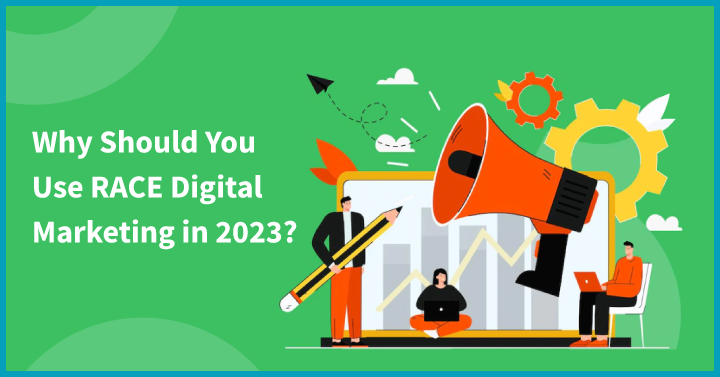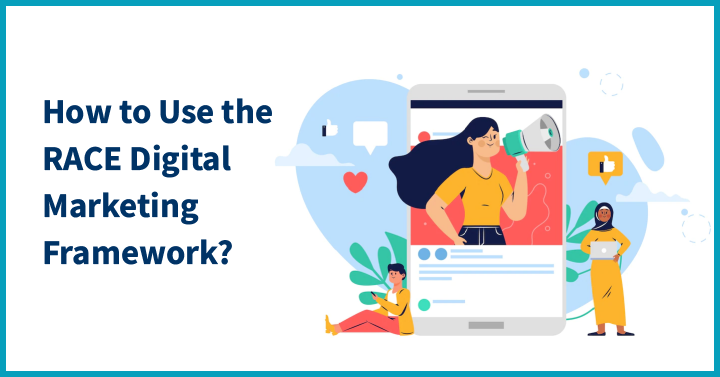The digital advertising and marketing industry has experienced tremendous growth in recent years. As per WordStream, “In 2020, the market was estimated at $350 billion, and projections suggest it will reach a staggering $786.2 billion by 2026”. With such exponential growth, it’s crucial for businesses to adopt effective strategies to stay ahead of the competition. One framework that has gained significant attention of the marketers is the RACE Digital Marketing Framework. This comprehensive approach can revolutionise your digital marketing strategy in 2023 and beyond.
The RACE Framework, which stands for Reach, Act, Convert, and Engage, is a proven methodology that helps businesses improve and manage their digital marketing campaigns. By understanding each stage of the framework and applying its principles, you can achieve the desired marketing results.
 In this blog, we will explore how the RACE framework can unlock success for your business in 2023.
In this blog, we will explore how the RACE framework can unlock success for your business in 2023.
2. Why Should You Use RACE Digital Marketing in 2023?

RACE digital marketing framework allows marketers to structure an action plan in such a way that it aligns with the purchasing stage of the user. Here are the primary reasons to use the RACE digital marketing strategy –
Customer-Centric Approach
RACE places customer at the core of your digital marketing strategy. It’s not just about broadcasting your message to a broad audience; it’s about understanding your customers’ needs, preferences, and behaviours at each stage of the marketing funnel. From the initial awareness stage to the final conversion, the strategy involves creating content, offers, and experiences that align with the customer’s lifecycle journey, fostering a sense of relevance and connection. This approach helps to promotes a lasting connection between the brand and its customers.
Omni-Channel
RACE acknowledges the multi-faceted nature of customer interactions. It spans across diverse online touchpoints, including websites, social media platforms, mobile apps, and more. It doesn’t just focus on one or two marketing channels; it covers a comprehensive array of activities. From targeted SEO to Social Media Optimisation, Social Media Marketing, and email marketing, the framework ensures that businesses leverage a diverse set of tools to engage with their audience. This approach is essential for adapting to the ever-evolving landscape of digital marketing.
Performance-Based Strategy
RACE is a performance-based strategy, as it is all about precision, accountability, and adaptability. It’s about using data to drive decisions, measuring impact with clarity, optimising in real-time, aligning with business goals, and ensuring that digital efforts are not just effective in isolation but contribute significantly to the success of the entire business. At every stage of the marketing funnel, well-defined Key Performance Indicators (KPIs) are established. This allows marketers to track performance efficiently and make informed and data-driven decisions based on real-time insights rather than relying on intuition alone.
Now that you know how the RACE digital Marketing Framework benefits a business, let’s understand the functioning of the Framework in detail.

3. What Does the RACE Digital Marketing Framework Mean?

RACE is the acronym of Reach, Act, Convert, and Engage, which involves curating buyer persona, pushing them through the marketing funnels, and eventually converting them.
Created by Dr.Dave Chaffey, co-founder of Smart Insights, the RACE framework provides solid and practical support in your digital marketing planning. It also helps you focus on the KPIs to manage the campaigns and drive results.
The RACE model is broken down into the below stages to help marketers create a well-formed marketing strategy. Before implementing the RACE framework, there is a planning stage that involves managing and optimising digital channels against defined targets. It includes designing the website and collating creative material, brand content, products, and services.
Let’s dive deep into different stages of RACE digital marketing –
1. Reach
The first stage, Reach, focuses on increasing brand visibility and attracting potential customers. There are various tactics a business can employ to achieve this, such as optimising the website for search engines, leveraging social media platforms, and utilising online advertising.
For example, publishing content on websites and blog networks, using Bing or Google ads, promoting user-generated content, and leveraging influencer-led content. The key is to drive visitors to your website and introduce your products and services to the target audience.
- Digital Marketing Tactics
It’s essential to employ various tactics such as:
-
- Search engine optimisation:
SEO plays a crucial role in improving your website’s visibility in search engine results. By optimising your website’s content and structure, you can rank higher in search engine rankings, leading to increased organic traffic. - Content marketing:
This involves creating valuable and relevant content that resonates with your target audience. The content can be in the form of blog posts, videos, infographics, or podcasts. - Social Media Advertising:
Lastly, social media advertising allows you to reach a wider audience by targeting specific demographics and interests.
- Search engine optimisation:
- KPIs to Measure
Measuring reach involves tracking KPIs that quantify the extent of your brand’s visibility and audience exposure. Here are some KPIs to measure Reach:
-
- Impressions:
The total number of times your content is displayed. - Reach:
The number of unique users who have seen your content. - Website Visits:
The number of users who visit your website. - Social Media Followers:
Track the growth in your social media following. - Likes, Shares, and Comments:
Monitor the interactions on your social media posts.
- Impressions:
- Case Study Example
Chi Chi London, an online fashion retailer, added a broader audience with Facebook dynamic ads. And guess what? The sales increased by 40%. The company used catalog sales campaigns by retargeting existing users with dynamic ads. Broad audience targeting helped the brand reach people who have expressed interest in its product, even if they haven’t visited its website or app.
 2. ACT
2. ACT
Once you have successfully reached your target audience, the next stage in the RACE Framework is Act. Act, short form of ‘INTERACT,’ is the decision-making stage involving clear customer journeys and a content hub capable of creating leads. It aims to encourage interactions on the website and social media and generate online leads.
For example, online quizzes are an effective lead magnet. You can create a practice quiz and encourage your audience to participate. People usually share their results with family or friends, encouraging others to take the quiz and see what they’d get.
- Digital Marketing Tactics
The key to success at this stage lies in:
-
- Optimising a Website’s User Experience:
This includes ensuring fast loading times, easy navigation, and mobile responsiveness. - Creating CTAs:
By creating persuasive CTAs, you can significantly increase conversion rates. CTAs should be clear, concise, and visually appealing, prompting users to take the desired action. - A/B testing:
This can help determine which CTAs are most effective for your target audience.
- Optimising a Website’s User Experience:
- KPIs to Measure –
To measure the effectiveness of your actions in this stage, you can track KPIs that reflect user engagement and conversion behaviours. Here are some KPIs to measure Act:
-
- Click-Through Rate (CTR):
The percentage of people who clicked on a specific link compared to the total number of users who viewed it. - Conversion Rate:
The percentage of users who complete a desired action. - Cost Per Conversion:
The average cost incurred for each conversion. - Social Media Engagement:
Likes, shares, comments, and other interactions on social media platforms. - Email Click-Through Rate (CTR):
The percentage of email recipients who clicked on links and completed the desired action.
- Click-Through Rate (CTR):
- Case Study Example
Barões Digital Publishing, a Brazilian company, used OutGrow to create an outcome quiz,”
which city should you move to in 2020? “for one of their clients, QuintoAndar. The quiz generated 64k leads and 134k visits, gaining considerable traction. Also, the conversion rate increased by 48%.
3. CONVERT
Once you have captured leads through the Act stage, the next step is to convert them into paying customers. In this stage the marketer invests in marketing automation, remarketing, and CRO to drive conversions. It is aimed at conversion to sales via online or offline channels.
For example, to increase the add-to-cart flows, Shopify experts have developed some exciting strategies like Instant Checkout, Direct to Cart, Animated Cart, and Sliding Drawer. In the Instant Checkout strategy, the users are sent directly to checkout, which increases their chances of completing the purchase.
- Digital Marketing Tactics
The essential components of this stage are:
-
- Personalisation:
It involves tailoring your marketing messages and offers to individual leads based on their specific needs and preferences. By providing personalised content and recommendations, you can build trust and increase the likelihood of conversion. - Automation:
It plays a crucial role in streamlining and scaling your lead nurturing process. By automating repetitive tasks, such as sending follow-up emails or triggering personalised offers based on user behaviour, you can save time and resources. - Lead scoring:
It helps prioritise leads based on their likelihood to convert. By assigning scores to leads based on their engagement level and demographic information, you can focus your efforts on the most promising prospects.
- Personalisation:
- KPIs to Measure –
To assess the success of your conversion strategies, it’s essential to track KPIs that reflect the effectiveness of your efforts in converting leads into actual sales. Here are some KPIs to measure Convert:
-
- Average Order Value (AOV):
The average amount spent by customers in a single transaction. - Revenue per Visitor (RPV):
The average amount of revenue generated per visitor to your website. - Shopping Cart Abandonment Rate:
The percentage of users who add products to their shopping cart but do not complete the purchase. - Customer Lifetime Value (CLV):
The total predicted revenue a customer is expected to generate over the entire duration of their relationship with your business. - Lead-to-Customer Conversion Rate:
The percentage of leads that eventually become paying customers.
- Average Order Value (AOV):
-
- Case Study Example
Walmart, one of America’s most prominent brands, took advantage of the new features of HTML to turn its Clunky website into a fully responsive website. As a result, the company saw a surge in online sales made through mobile devices. The overall conversion increased by 20%.
 4. ENGAGE
4. ENGAGE
Engage is the final stage, where you start marketing activities to develop a long-term relationship with your customers. It involves engaging your customers for repeat sales, referrals, social media marketing, etc., to build customer loyalty as repeat purchases using your social media presence, direct interactions, emails, etc.
For example, you can send promotional emails to your existing customers suggesting a product, even if the margin is less. Or set up service call appointments based on the customer’s preferred hours.
- Digital Marketing Tactics
The tactics in this stage include:
-
- Email marketing:
It allows you to stay top-of-mind with your audience by delivering relevant content directly to their inbox. - Social media engagement:
It involves actively interacting with your audience through comments, messages, and social media posts. - Loyalty program:
Implementing a loyalty program can incentivise repeat purchases and encourage customers to refer your brand to others.
- Email marketing:
- KPIs to Measure
To measure the effectiveness of your engagement strategies, it’s important to track KPIs that reflect customer engagement, satisfaction, and loyalty. Here are some KPIs to measure Engage:
-
- Referral Rate:
The percentage of customers who refer your products or services to others. - Customer Satisfaction (CSAT) and Net Promoter Score (NPS):
Measures customer satisfaction and likelihood to recommend your brand to others. - Surveys and Feedback:
Measure the response rates for customer surveys. - Upsell and Cross-Sell Metrics:
The percentage of customers who upgrade to a higher-tier product (upsell) or purchase additional complementary products (cross-sell). - Repeat Purchase Rate:
The percentage of customers who make multiple purchases.
- Referral Rate:
- Case Study Example
Tesla, a leading manufacturer of electric & solar cars, implemented a referral program that gave a $1,000 discount on a new order to referred persons and existing customers. What’s more from Tesla? If an existing customer referred ten people, they get the ‘rights’ to buy Model X SUV, a limited founder series. Tesla’s referral program changed many times, where they relied on their loyal customers to promote their brand.
4. How to Use the RACE Digital Marketing Framework?

RACE digital marketing is an inexpensive and effective way of marketing compared to traditional marketing methods. Here is a step-by-step guide to using the RACE digital marketing framework-
- Step 1 – PLAN
-
- Define your marketing goals and objectives
- Prepare an actionable marketing strategy
- Build a strong social media profile
- Claim Google Business profile
- Use consistent branding and advertising
- Step 2 – REACH
-
- Build a responsive and highly engaging website
- Regularly publish blog posts to engage the audience (inbound marketing)
- Optimise your website for search engines like Google, Yahoo, and Bing with a solid link-building strategy
- Create engaging social media posts to attract new followers and engage the existing ones
- Invest in email marketing, video marketing, and PPC advertising to reach a more comprehensive audience
- Step 3 – ACT
-
- Draw insights from Google Analytics and Search Console
- Keep a tab on sessions, bounce rate, session duration, acquisition, traffic, etc
- Conduct A/B testing for content, design, and CTA
- Use landing pages, signup forms, and registration forms to attract leads
- Step 4 – CONVERT
-
- Optimise the conversion rate by offering FREE consultation, coupons, or offers
- Add testimonials and success stories on the home page
- Retarget users who leave your website without taking any action
- Nurture leads through the email marketing campaign
- Step 5 – ENGAGE
-
- Engage your existing customers by getting in touch with them via emails, polls, surveys, reviews, etc
- Send them regular updates about your company
- Stay active on social media by responding to the comments
- Take the opinion of your customers to make your services better
 RACE digital marketing is not a one-time job but an ongoing journey. Therefore, it is advised to measure, test, and optimise the strategy based on actual results. Then, with the right strategy, one can drive quality leads and increase conversions.
RACE digital marketing is not a one-time job but an ongoing journey. Therefore, it is advised to measure, test, and optimise the strategy based on actual results. Then, with the right strategy, one can drive quality leads and increase conversions.
5. Conclusion
In conclusion, the RACE Digital Marketing Framework provides a holistic approach to digital marketing strategy, covering all stages of the customer journey. By implementing the Reach, Act, Convert, and Engage stages effectively, businesses can stay ahead of the competition in the ever-evolving digital landscape. Remember to set clear goals, understand your target audience, and utilize the right tools and resources to support your implementation.
If you would like to know more about RACE digital marketing, get in touch with us. At Growth Ganik, we help you create a successful digital marketing plan that drives results.
6. How Can a Digital Marketing Agency Help?
A digital marketing agency has the expertise and experience to develop and implement a comprehensive strategy based on the RACE Framework. Their in-depth knowledge of the industry, access to the latest tools and technologies, and a team of experts are dedicated to driving results.
Growth Ganik is a full-stack digital agency that specialises in customising digital marketing strategies that align with the unique goals and requirements of our clients’ businesses. Our team of experts have proficiency across various frameworks, including the RACE framework. So, whether you need assistance with market research, content creation, website optimisation, or marketing automation, our agency can provide the support you need.
Don’t hesitate to reach out to us today and take your digital marketing strategy to the next level!
7. FAQs
- What does RACE mean in marketing?
RACE stands for Reach, Act, Convert and Engage – a classic digital marketing funnel.
- Who created the RACE marketing model?
Yes, the RACE Framework is applicable to businesses of all sizes and industries. Whether you are a small startup or a multinational corporation, the RACE Framework provides a comprehensive and adaptable approach to digital marketing.
The RACE model was created by Dr.Dave Chaffey, the co-founder, and director of Smart Insights.
- Is the RACE Digital Marketing Framework suitable for all businesses?
Yes, the RACE Framework is applicable to businesses of all sizes and industries. Whether you are a small startup or a multinational corporation, the RACE Framework provides a comprehensive and adaptable approach to digital marketing.
- Can I implement the RACE Framework alongside other marketing frameworks?
Absolutely! The RACE Framework is designed to complement and enhance other marketing frameworks, such as the AIDA model or the Customer Value Journey. By incorporating the RACE Framework into your existing strategies, you can create a more robust and effective marketing plan.
- How long does it take to see results with the RACE Framework?
The timeline for seeing results with the RACE Framework varies depending on factors, such as your industry, target audience, and the resources allocated to your digital marketing efforts. However, by consistently implementing the strategies outlined in the RACE Framework and monitoring your campaigns’ performance, you can expect to see positive results within a few months.











